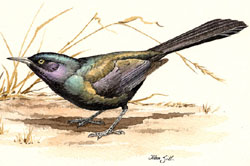Breeding Bird Atlases (BBA)
Find a Bird - BBA1
Breeding Bird Atlas 1 Species Accounts
Common Grackle
Quiscalus quiscula
Egg Dates
April 15 to June 28
Number of Broods
one; sometimes two; may re-nest if first attempt fails

The Common Grackle is a survivor, able to adapt to the radical changes in environment brought about by civilization and to withstand direct human persecution. Depredation of crops during the 1800s led to a campaign of bounties and extermination in colonial days. By the first part of the twentieth century, however, the species was once again observed migrating in incredibly huge flocks. The grackle was a common breeder during the Atlas period, nesting statewide, although its numbers appear to have declined somewhat in recent decades.
Grackles often arrive during the last week of February or the first week of March. They are most commonly found in open fields and pastures but also frequent city parks, campuses, large lawns, golf courses, and salt marshes. The first grackles of spring are males, but within a week the females begin to arrive. Grackles typically nest in colonies of a few to over a hundred pairs, often in White Pine groves near water, and the same site will be used year after year. Individual territories are small and include only the nest site and its immediate vicinity. Several nests may be placed in a given tree, usually somewhat spaced but at times as close as 4 feet.
The song is a distinctive, harsh, creeky kobuga-leek, with a pronounced metallic quality that suggests a rusty hinge. Courting males accompany the song with a display that involves puffing up the feathers, partly opening the wings, and lowering and spreading the tail. In flight, the tail takes on a distinctive keeled shape. Several males may follow a single female, and at times they fight fiercely, alternately fluttering up at one another and locking together to grapple with bills and feet. Once a pair has formed, the male accompanies the female to and from the colony, following her closely in flight. Other common vocalizations are a loud chuck or tchack and a tssh-shklee; as well as a rapid series of chuck notes with an occasional longer churr interspersed.
Nest building begins in April. In Massachusetts, nests have been found in White Pine, Pitch Pine, Red Pine, Norway Spruce, Blue Spruce, Red Cedar, maple, apple, and alder, as well as in cattails and various bushes including blueberry and Buttonbush; also on the posts and cross beams of piers, on the downspout supports of buildings, and on a pipe in a wall. Nest heights are variable, ranging from 1 to 10 feet for the low vegetation and pier nests to 25 to 60 feet for the tallest tree nests (ACB, CNR, Meservey).
The nest, a bulky mass of sticks, coarse grass, and rootlets, with the interior plastered with mud and lined with fine grass, is deeply cupped. Grackles lay three to six eggs. Clutch sizes for 15 state nests ranged from three to five eggs (ACB, DKW, CNR). The female performs incubation for about 14 days. After the young hatch, the male assists the female in feeding the young, which fledge after approximately two weeks. In Massachusetts, nestlings have been reported from April 27 to July 9 (CNR, Meservey). The earliest recorded fledge date was May 10, and the peak period of fledging has been May 15 to May 28, with a second and smaller peak from June 28 to July 4 (Meservey).
Brood sizes for 16 state nests ranged from two to four young, with two representing the commonest number of young fledged. Nest failure is common, mostly due to predation by hawks and Red Squirrels, and also to high winds that knock entire nests to the ground. Grackles will defend their young fiercely, and alarm calls of an adult or a distress cry by a youngster will cause an entire colony to rally for a concerted attack.
The Common Grackle is a single-brooded species; however, there are reports in the literature of two broods. Many of the fledglings that continue to appear throughout June and into July are the result of renesting attempts. Young grackles continue to be fed by the adults, at least occasionally, for several weeks after fledging. From June through August, the drab juvenal feathers are gradually replaced by the glossy subadult plumage. Adults have a complete molt from August to October.
Beginning in mid-July, grackles begin to fly at sunset in flocks to large roosts, which they often share with other species, and by September these flocks are joined by migrant grackles. During September and October, large flocks feed in corn- and stubble fields, and also on mast in deciduous forests. Grackles reach peak numbers in early November and then begin to move south with the onset of winter. In milder years, substantial numbers may overwinter in favorable locations. Winter mortality may be heavy, particularly when bitter cold spells follow snow- or ice storms. Most grackles spend the winter in the southern United States.
Map Legend and Data Summary
Atlas 1 data collected from 1975-1979


Note: very common throughout the state in a wide variety of habitats
Margaret W. Argue and W. Roger Merservey



